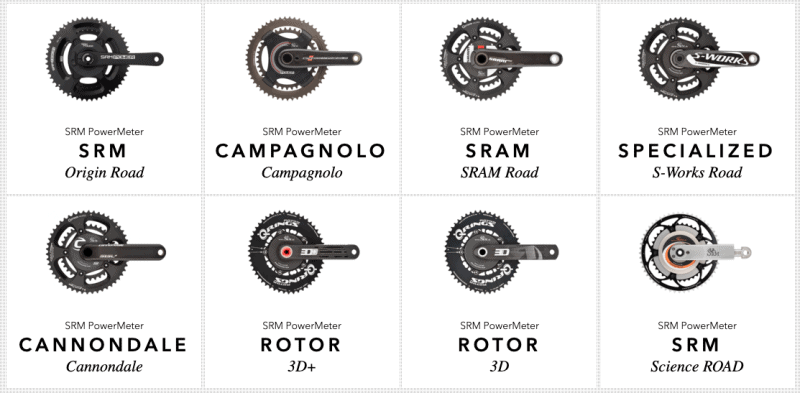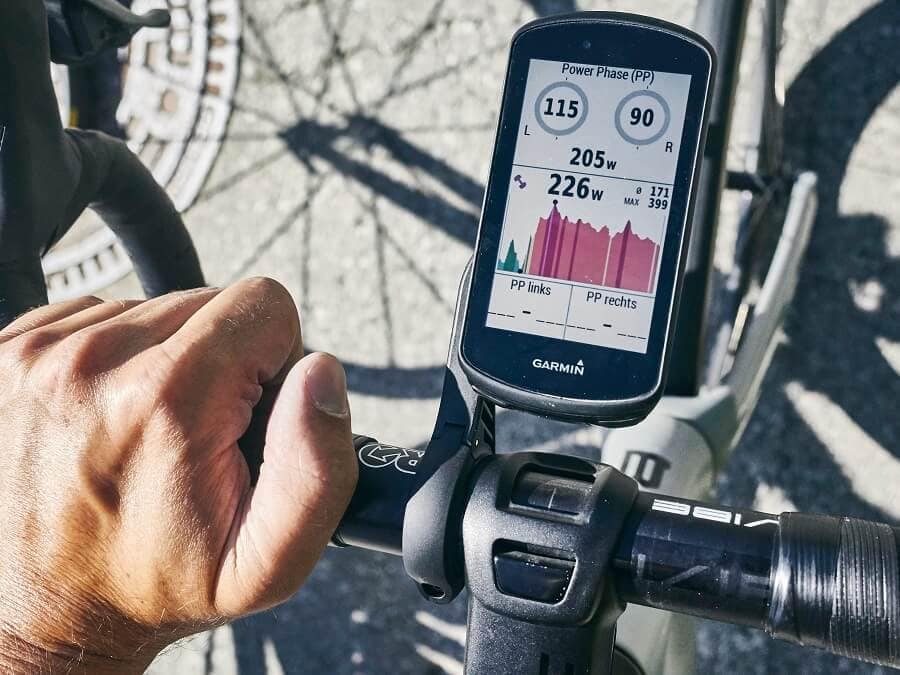SRAM Etap vs Shimano Di2 – Which is Better?
Update : With the availability of SRAM Red and more recently, Force eTap AXS, I’ll be updating this article in the coming weeks once I get a complete understanding of how they work.
My first impression is, SRAM has finally caught up with the Shimano Di2 in terms of customization and features. Wireless is nice to have, but it comes with a very heavy price tag.
If you’re looking to get a major upgrade from mechanical to electronic shifting, this is the ideal time for 2 reasons. The introduction of Force eTap has brought down the prices of not only the Red eTap (available at Competitive Cyclist and Jenson USA) but also both the Shimano Dura-Ace and Ultegra Di2 groupsets (available at Amazon).
–
You’re probably considering going down the electronic groupset path and that’s why you’re here.
Let me start by saying this.
You definitely won’t regret going for electronic shifting. So now the question comes down to, which electronic shifting system is it?
SRAM eTap vs Shimano Di2?
Perhaps Campagnolo EPS?
I’ll share with you which is the best electronic groupset (from my experience) that represents the best value for money.
I’ll also do a detailed comparison between the Shimano Di2 and SRAM eTap.
Read More :
As for now, I’ll leave Campagnolo’s EPS aside. That’s for another day.
Before we begin, this won’t be a full-on review on the entire Dura-Ace Di2, Ultegra Di2, or SRAM Red eTap electronic groupset.
The main focus will be on the electronic shifting side.
Best Value for Money Electronic Groupset - Shimano Ultegra Di2
This is going to be a long post.
So I’d let you know right away which electronic groupset I think represents the best value for money today.
It’s the Shimano Ultegra Di2.
Functionalities wise, the Ultegra Di2 is exactly the same as the Dura-Ace Di2. They even look the same except for the Ultegra wording which is not really noticeable unless you take a really close look.
Read More : Shimano Ultegra Di2 vs Dura-Ace Di2 vs SRAM Red eTap Weight
Another difference is obviously, the weight which is due to the different materials used. But for now, here’s an important question to ask yourself.
Ask Yourself : Are you upgrading your existing groupset or getting a new bike altogether?
If you’re upgrading your existing groupset, you’ll only need the upgrade kit which consists of the front and rear derailleurs, shifters, batteries, charger, and cables.
If you’re currently using the mechanical SRAM Red22, then you might want to stay with SRAM and go for the Red eTap. The brakes are the same except if you’re going after hydraulic disc brakes.
Alternatively, you might also want to consider the Shimano Ultegra Di2.
Even if that involves changing the brakes, the whole package (including brakes) would cost you around the same price for the SRAM Red eTap upgrade kit. You can also reuse the existing Red 22 brakes if you’re not fussy about mismatch looks.
But if you’re getting a new bike, then you can start from the ground up, especially with the braking system. Most cyclists I know would go for hydraulic disc brakes.
Yes, they do look cool.
Here’s a quick comparison table between the Shimano Di2 and SRAM eTap.
Shimano Di2 - The Basics
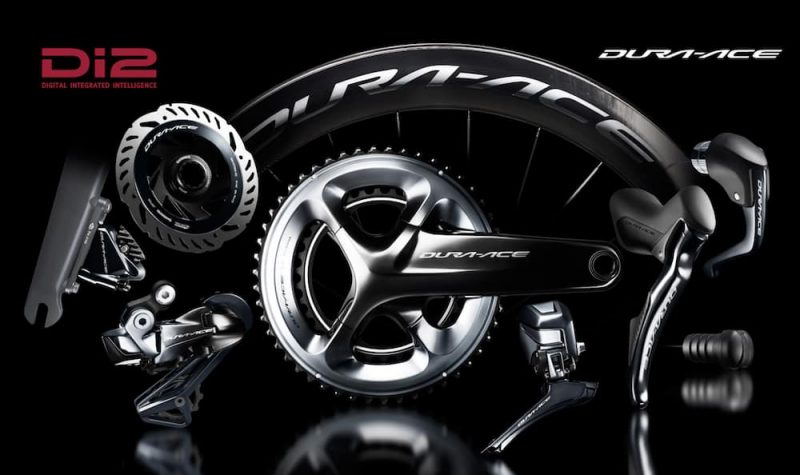
The current Shimano Dura-Ace and Ultegra Di2 groupsets were launched during the 2016 Tour de France. Both are available in the rim (dual pivot and direct mount) and hydraulic disc brakes versions.
In case you’re wondering, Di2 is the acronym for Digital Integrated Intelligence.
So let’s break both of them down.
Shimano Dura-Ace 9100 Series
- ST-R9100 – Mechanical shifting, rim brakes
- ST-R9120 – Mechanical shifting, hydraulic disc brakes
- ST-R9150 – Di2 shifting, rim brakes
- ST-R9170 – Di2 shifting, hydraulic disc brakes
Shimano Ultegra R8000 Series
- ST-R8000 – Mechanical shifting, rim brakes
- ST-R8020 – Mechanical shifting, hydraulic disc brakes
- ST-R8050 – Di2 shifting, rim brakes
- ST-R8070 – Di2 shifting, hydraulic disc brakes
Shimano Di2 Pros
- Fully Customisable. Shifting patterns and buttons can be customized according to your liking using the Shimano E-Tube app.
- Consistent Ergonomics. Both the rim and disc brake shifter hoods have the same feel and ergonomics.
- Longer Battery Life. A single charge would last up to 120 hours, which equates to anywhere between 1.5 to 4 months.
- Gearing Options. A standard derailleur cage can take up to 30T while a long cage (Ultegra only) can take up to 34T.
Shimano Di2 Cons
- Single Battery. The entire Di2 shifting system can’t be used should the battery run flat mid-ride. It’s not easily swappable.
- Wireless Capabilities. A separate wireless unit and cable to be purchased separately to add ANT+ and Bluetooth capabilities.
SRAM Red eTap - The Basics
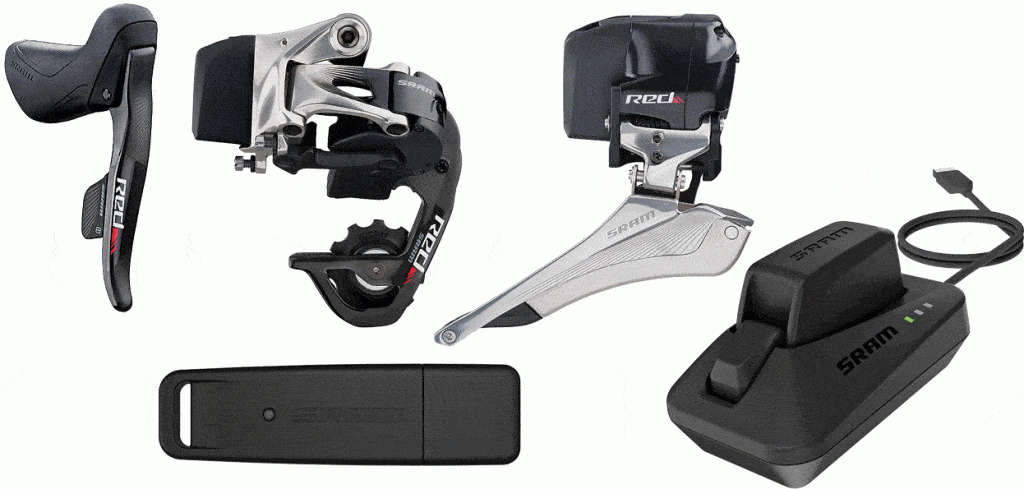
eTap is the next generation, electronic shifting system from SRAM, replacing their famous mechanical shifting, the Double Tap. eTap refers to Electronic Tap.
There are two variants of the SRAM Red eTap; rim brakes (dual pivot and direct mount) and hydraulic disc brakes (commonly referred to as HRD, or Hydraulic Road Disc).
Unlike Shimano, SRAM doesn’t have a mid-tier electronic groupset for the SRAM Force. But things could change with the impending official SRAM Red eTap 12 speed announcement.
At the Saitama Tour de France Criterium in Japan back in early November 2018, SRAM teased us with a 12 speed Red eTap groupset. It was spotted by Japanese photographer Kei Tsuji on Katusha Alpecin’s Nils Pollitt bike.
SRAM eTap Pros
- Fully Wireless. Uses Airea (SRAM’s own wireless communication protocol) and supports ANT+ out from the box.
- Aesthetically Pleasing. Zero cables on the front end of the bike make the setup look very clean.
- Swappable Batteries. Derailleur batteries are swappable between front and rear, and with others should you get a flat battery mid-ride.
- Easy Installation. With no cables involved, installation is a breeze.
SRAM eTap Cons
- Gearing Options. A standard derailleur cage can take up to only 28T. To go up to 32T, the WiFli derailleur is needed.
- Non-customizable Shifting. There are no options for you to customize the shifter buttons to your preference.
SRAM eTap vs Shimano Di2 System
Both the Di2 and eTap are based on an electronic shifting system that gives cyclists fast and precise shifting. There are no elder and worn out shifter cables to deal with, frequent gear indexing, and sluggish front derailleur shift.
While the end goal is the same, the way Shimano and SRAM implement their electronic shifting system is miles apart.
I’ll take you through the differences in the following sections.
1. Wired vs Wireless
Shimano launched their first commercial Di2 groupset back in 2009 while SRAM was late to the party with its Red eTap groupset only available in early 2016.
Prior to this, Mavic had also tried twice to introduce electronic shifting in the ’90s with the Zap in 1992 and Mektronic in 1999. Both failed to gain any meaningful traction due to reliability issues and never seen daylight since then.
The first major and obvious difference between the Di2 and eTap is the wired vs wireless system.
SRAM uses their own proprietary wireless communication protocol called Airea which operates on the 2.4Ghz frequency band, the same frequency band your home WiFi router operates on. Airea is used to communicate between the shifters and derailleurs.
SRAM claims that it uses 128-bit rolling encryption that’s so secure that even the people who developed it, can’t hack it. In short, you don’t have to worry about the cyclist next to you messing up with your shifts.
In case you’re wondering, the eTap shifting system does support the ANT+ protocol.
It was the first-ever electronic groupset to use the ANT+ Shifting device profile, enabling you to see your current gear and battery status on compatible GPS head units like the Garmin Edge 520/1020 and Wahoo Elemnt.
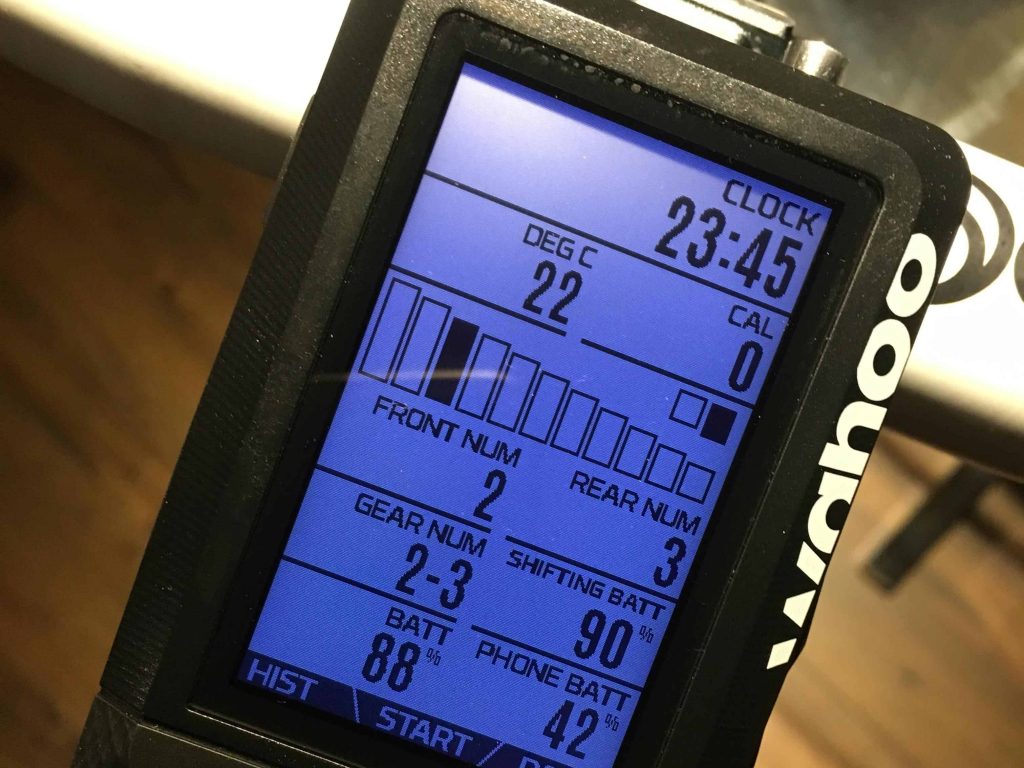
On the other hand, the Shimano maintains its wired electronic shifting for their 3rd generation Di2. According to Shimano, the pros told them that the Di2 system is so reliable that there’s no need to change them.
Having said that, there’s a wireless component in the Di2 system where it supports ANT+ and Bluetooth. To make this happen, you’ll need to buy the Wireless Unit (EW-WU111), or formerly known as the D-Fly in the previous generation.
Unfortunately, it doesn’t come with the Di2 out from the box. You’ll also need to buy an additional short cable, preferably 150mm.
Be warned that there are numerous stories about performing a software update on the Di2 system wirelessly. There are many instances that the software update fails and bricks the entire system. Always update the Di2 software via PC (Mac is not supported) and only use the wireless unit to make changes to how you want the shifts to work.
Winner : SRAM eTap for its complete wireless shifting solution.
2. Weight Comparison
Let’s start with the most important question most of us have.
What’s the weight difference between the Shimano Ultegra Di2 vs Shimano Dura-Ace Di2 vs the SRAM Red eTap?
Here’s a quick comparison of the weight differences. We’ll take a closer look at the weight of each component in the later sections.
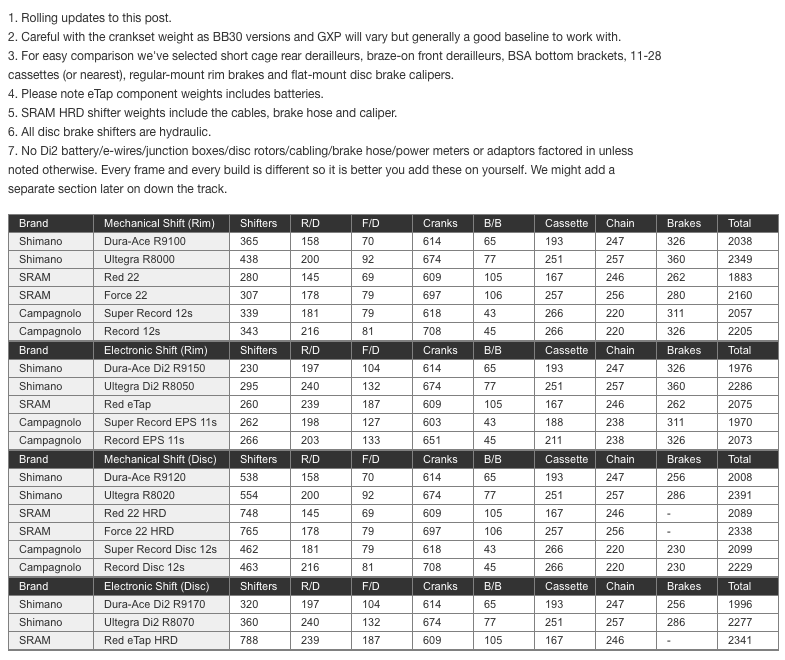
From the table above, you can see that the mechanical SRAM Red 22 is still the lightest groupset.
But once you move into the electronic shifting territory, things get a little murky and there’s really no clear winner here. You’re probably looking at around 200g to 300g additional weight gain when moving from a mechanical groupset to an electronic groupset.
While you got rid of all the derailleur cables, you’re also adding in things such as batteries, junction boxes, and electronic cables. Or perhaps satellite shifters if you want more customization.
The weight difference is minimal in my opinion. You’re basically paying a premium if you opt for the Dura-Ace Di2 instead of the Ultegra Di2.
Here’s a quick low down of the weight differences of the complete groupsets.
Rim Brakes
- Shimano Ultegra R8050 vs Dura-Ace R9150 : 2286g vs 1976g = 310g
- Shimano Ultegra R8050 vs SRAM eTap : 2286g vs 2075g = 211g
- Shimano Dura-Ace R9150 vs SRAM eTap : 1976g vs 2075g = 99g
Hydraulic Disc Brakes
- Shimano Ultegra R8070 vs Dura-Ace R9170 : 2277g vs 1996g = 281g
- Shimano Ultegra R8050 vs SRAM eTap : 2277 vs 2341g = 64g
- Shimano Dura-Ace R9170 vs SRAM eTap : 1996 vs 2341g = 345g
Winner : Tie
3. Aesthetics
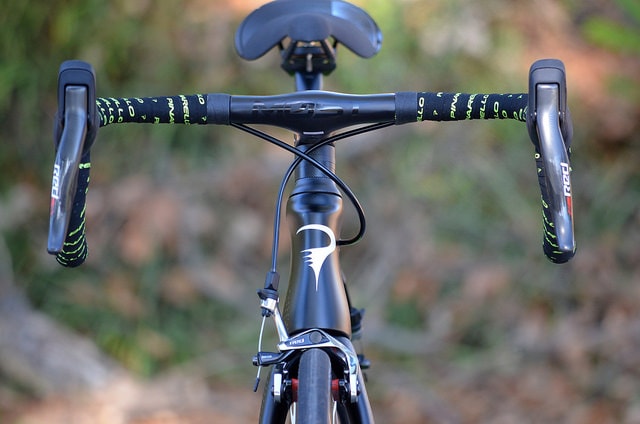
There are no derailleurs cables needed for the eTap except for the brake cables. This makes the eTap aesthetically pleasing to the eyes. If you have an old bike frame that doesn’t have all the cable routing needed for a Shimano Di2 system, eTap is a great choice if you decide to pimp it up.
Meanwhile, with the Di2, Shimano has greatly reduced the number of cables visible. There are no more shift cables for the front and rear derailleurs visible on the handlebars and the ugly cable loop at the rear derailleur.
There are only 2 cables visible; one from the handlebar/junction box into the head tube and another from the seat stay to the rear derailleurs.
Winner : SRAM eTap for its clean looks.
4. Shifter Hoods Ergonomics
The eTAP shifters are now slightly smaller compared to the Red 22. It’s to accommodate a wider range of hand sizes, especially for female cyclists. Gone are the famed Double Tap paddles and replaced by a single large shift paddle on each shifter.
Apart from that, it’s very similar to the Red 22 version.
Shimano Di2 Shifters
On the other hand, the Shimano Di2 shifters have undergone a major update. The hoods have shrunk significantly for the rim brake version and even more for the hydraulic disc brake version.
You can tell just by looking at it.
The brake levers now have a slimmer frontal view, giving you a very minor aerodynamics gain and the shift buttons are slightly larger, which is handy if you’re wearing full-finger winter gloves.
The larger buttons also give a better tactile feel whenever you press on them, ensuring you don’t miss a gear shift.
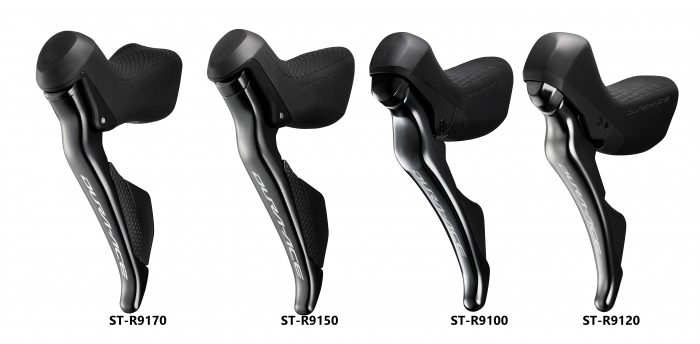
But that’s not all.
The main talking point is how the Dura-Ace Di2 hoods for hydraulic disc now look and feel exactly the same as the rim brakes version.
In the past, it was slightly taller to accommodate the hydraulic master cylinder. The Ultegra Di2 hydraulic hoods had also shrunken, but it’s still a tad chunkier than its rim brake’s equivalent.
No such update for the eTap yet. The eTap hydraulic disc brake hoods are still taller than the rim brake version.
Winner : Shimano Di2 for having a much smaller hood and the same feel across both rim and hydraulic disc versions.
5. Installation and Initial Set Up
When it comes to installing an electronic groupset, nothing beats the eTap.
Because it’s wireless, you don’t have to fish cables in and out of the bike frame, risk connecting the wrong cables, or having incorrect cable lengths.
SRAM Red eTap Set Up
An experienced bike mechanic can get the eTap installed in under 30 minutes. It’ll probably take you up to 60 minutes, especially if it’s your first time doing it. SRAM made a very good and detailed video on how to install the eTap by yourself at home.
All it takes to pair the shifters and derailleurs are to press the function button on each shift paddle, and they’ll begin pairing automatically.
Once done, there’s nothing more to customize.
Shimano Di2 Set Up
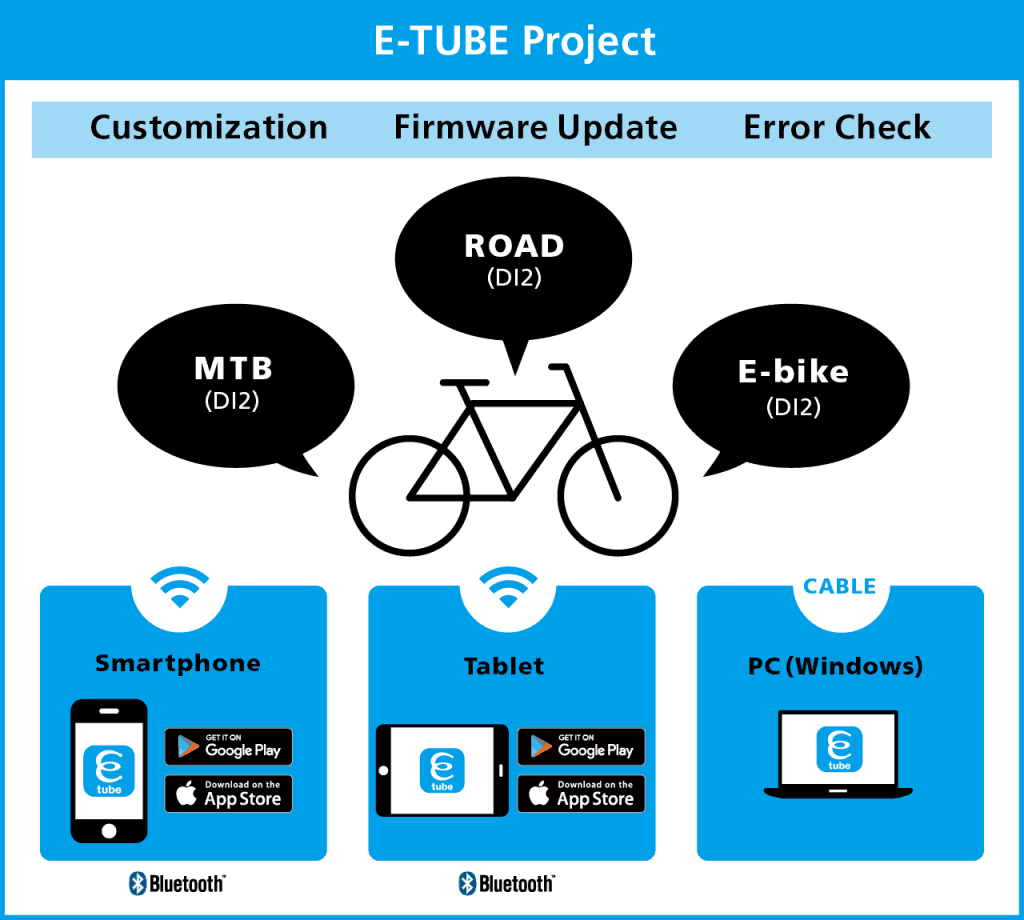
The Shimano Di2 set up is more complicated with various bits and pieces to put together. There are two junction boxes, various cables, and batteries to install inside the bike frame itself.
Once everything is installed, you can customize how you want the shifter buttons to work according to your liking. To do this, you’ll need to install the E-Tube app either on your phone/tablet or PC.
The E-tube app works across iOS, Android, Windows, but not MacOS.
Winner : SRAM eTap for its ease of installation and setup.
6. Shifting Performance
Electronic shifting has a massive advantage over mechanical shifting when it comes to precision. Mechanical shifting relies on cable tension, which over time are prone to being elongated, leading to less than precise shifts.
With electronic shifting, you now have a very consistent, precise shifting coupled ability to micro-adjust on the fly, if needed.
Micro Shifting
Micro-shifting moves the rear derailleur 0.25mm in each direction.
To enable this on the eTap, you’ll need to press the Function button at the back of the shift paddle. The direction the rear derailleur moves depends on the shift paddle that you’ve just pressed.
For the Shimano Di2, you’ll need to enter into adjustment mode by pressing the button at the junction box and then either shift up/down.
eTap Wireless Shifting
Unlike the previous SRAM shifters, the eTap uses only two paddles, one on each shifter to control the shifts.
Pressing the right paddle shifts the chain to the lower cog, while the left paddle shifts the chain to the bigger cog. Pressing both paddles simultaneously shifts the front derailleur.
For those who like to place their hands on top of the handlebar during climbs, you can get the satellite shifter, or what SRAM calls Blips. These are wired and are connected to the shifters.
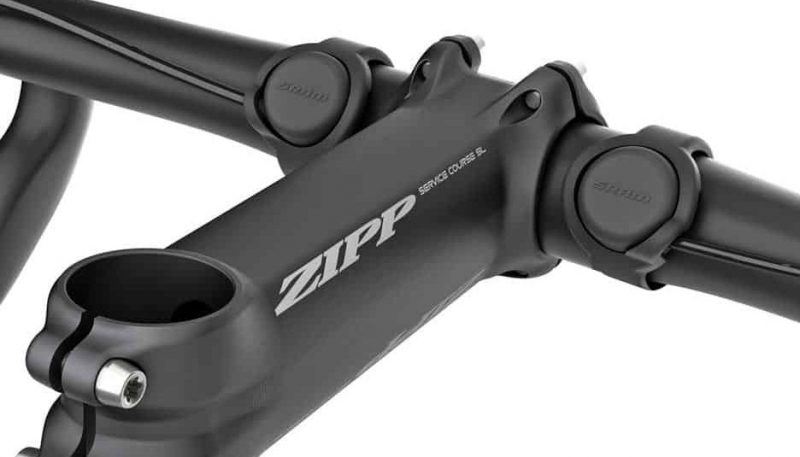
For maintenance work, there’s a small shift button on the derailleurs to make indexing easy at the workshop or at home.
The front derailleur has a built-in smart shift functionality. Here’s what SRAM says about it.
Depending on which gear you’ve selected on the rear derailleur, the eTap front derailleur will vary how far it initially moves the chain before settling in a moment later to its final position relative to the chainring selected.
Overall shifting is crisp and precise as expected.
However, there are feedbacks from many cyclists that there is a minor delay between pressing the shift paddle and the gear shifts. SRAM has come out to say that this is done on purpose to prolong the battery life.
Customisable Shimano Di2 Shifting
Unlike the eTap, the Shimano Di2 is fully customizable through the E-Tube app. You can connect the Di2 system to either your PC (wired) or your smartphone/tablet via Bluetooth.
For the Bluetooth option, you’ll need to have the wireless unit (EW-WU111) which isn’t included by default. With the E-Tube app, you can even transfer your Di2 settings from one bike to another.
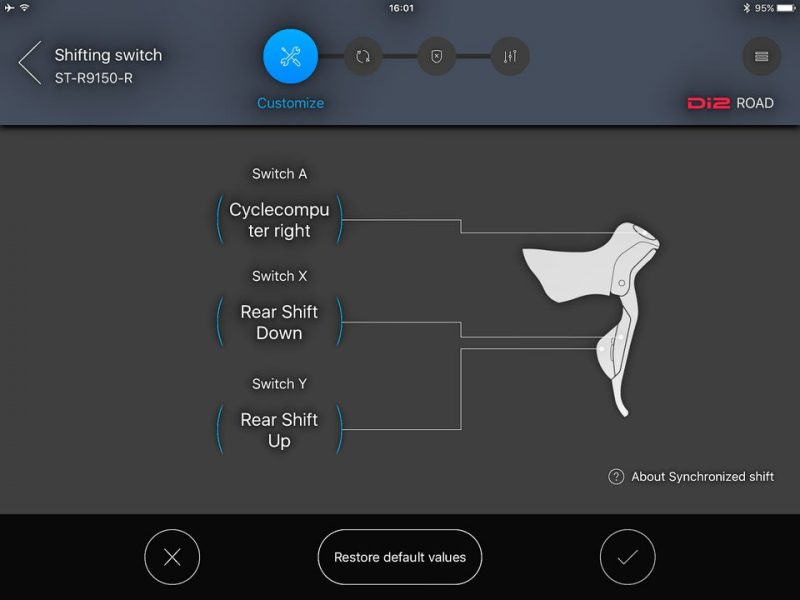
On each shifter, there are two buttons on the brake levers and one button at the top of the hoods. You can customize how you use these buttons according to your liking.
A very common setting is to have the button on the left lever control the front derailleur, right for rear derailleurs, and the buttons on the hood to scroll the pages on your Garmin or Wahoo head unit.
There’s also an option for satellite shifters if you’d wish your bike set up to be similar to Chris Froome’s.
Read More : Wahoo Elemnt vs Bolt vs Roam – Which One to Get?
Shimano Shadow Technology
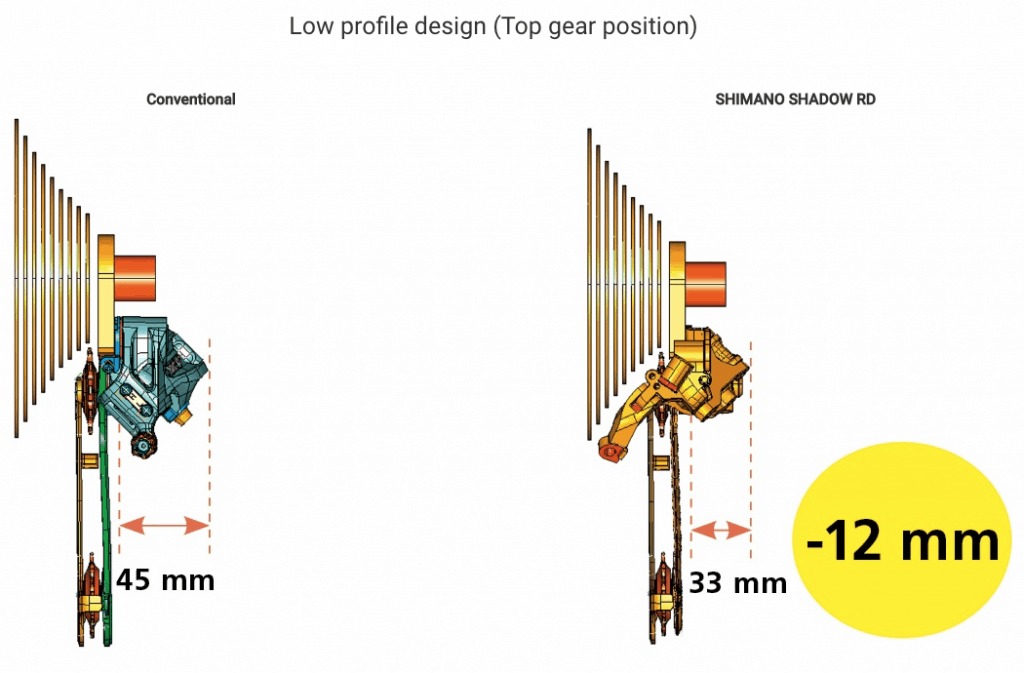
The Shadow technology has been a mainstay in Shimano’s mountain bike groupsets (Deore onwards) for a long time. Only recently did Shimano finally make it available to the road groupsets, both electronic and mechanical.
With Shadow Technology, the derailleur body is now positioned directly below the cassette rather than outward, to its right regardless of whether it’s in high or low gear.
Here’s what Shimano says about the Shadow Technology.
Because of its low profile and single tension construction, the derailleur does not hit the chainstay in rough riding conditions. The result is smooth and silent performance.
Shimano Synchro Shifting
The Synchro Shifting is where the Shimano Di2 sets itself apart from the eTap. It’s backward compatible with the previous R6870 and R9070 Di2.
The idea behind Synchro Shifting is an automatic front derailleur shift, depending on where the chain is at the rear cassette. In other words, you’ll never need to shift the front derailleurs, making your bike like a 1X.
To enable Synchro Shifting, you’ll need to have the latest battery unit, either the internal version (BT-DN110) or external (BM-DN100) and a software update. The newer battery has a larger memory size and processing power which is required by Synchro Shifting.
Take note that the previous battery (SM-BTR2) looks exactly like the new one (BT-DN110), but doesn’t support Synchro Shifting.
There are 3 settings when it comes to Synchro Shifting.
- Fully Manual. This is similar to how you’d usually shift. The shifts only happen when you press the buttons.
- Semi Synchro. This is where the rear derailleur will shift automatically in response to the front derailleur shift. For example, you’re running 53T x 25T and you shift the front to a 39T. With this, the rear will automatically shift to the 18T so that you’ll get to maintain the same gear ratio and cadence, and vice versa.
- Fully Synchro. With Fully Synchro, you won’t need to worry about shifting the front derailleurs. It will shift automatically depending on which cog you’re on the cassette. You can program where the shift happens via the E-Tube app. For example, you can configure the front derailleur to shift to the small ring when you’re at 25T, 21T, or even at 17T, and vice versa.
Here’s what Shimano says about Synchro Shifting.
Synchronized Shifting is designed to complement rather than replace manual shifting and is especially useful when you are using auxiliary sprint, climbing or TT shifters, or, for Dura-Ace, the shifter buttons on the top of the hoods.
In short, if you’re climbing with your hands on top of the handlebar, you can easily shift the front derailleurs by just shifting the rear derailleurs. The gear change at the rear will trigger the front derailleur to shift.
Winner : Shimano Di2 for its fully customizable shifting.
7. Gearing
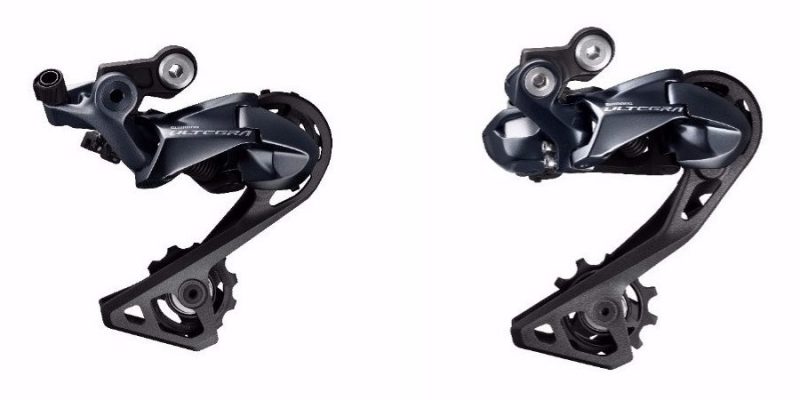
These days it’s not uncommon to see gearing that goes up to 32T or even 34T. Even the pros ride 30T or 32T on really mountainous days in the Grand Tours, like at the 2017 Vuelta Espane.
Both the standard cage Shimano Ultegra Di2 (R8050) and Dura-Ace Di2 (R9150) rear derailleurs can be used for 11-30T. But if you need to go up to 34T, it’s only available in the Ultegra Di2 medium cage variant.
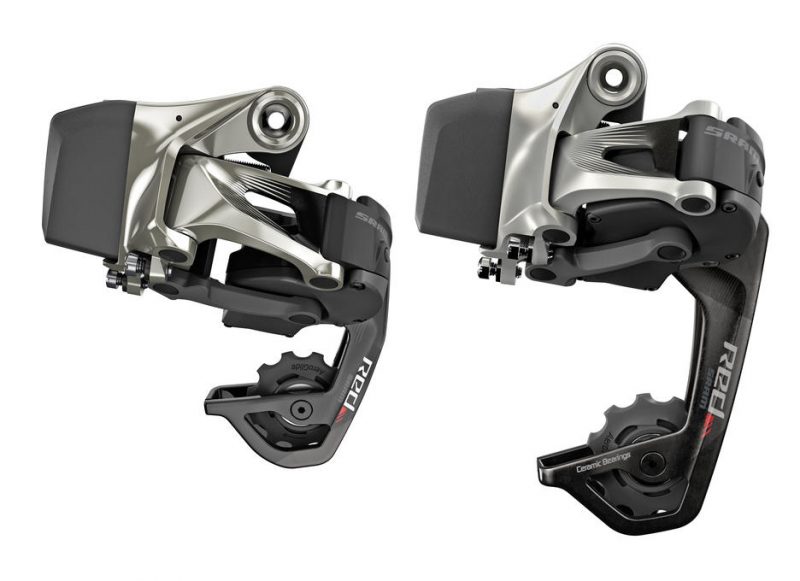
Meanwhile, the eTap rear derailleurs come in two variants; the standard derailleur cage supports 11-28T, and the long-cage, WiFli supports 11-32T.
There are major differences between the two variants besides the WiFli having a longer derailleur cage. The WiFli derailleur’s upper pulley has a greater offset to provide more clearance between the pulley and the cassette.
Another difference is the WiFli derailleur is positioned higher and further rearward to allow for more clearance between the upper pulley wheels and cassette especially the 32T. Hence, you can’t simply replace the standard derailleur with the longer WiFli cage. It’s much more complex than that.
Winner : Shimano Di2 for its ability to take up to 30T on a standard derailleur cage and 34T on a medium derailleur cage (for Ultegra).
8. Battery Life
The batteries are the heart of every electronic groupset. SRAM and Shimano have opted for a different method for this.
Removeable eTap Batteries
The eTap requires four batteries in total to operate; one rechargeable battery each in the derailleurs and one CR2032 coin battery in each shifter.
The derailleur batteries have around 60 hours of usage, which equates to around 600 miles of riding. The CR2032 coin batteries can last up to 2 years and can be easily changed at home by unscrewing the battery caps under the rubber hoods.
With removable batteries used in the eTap, you can easily swap the front and rear derailleur batteries. If you’re really unlucky in the event both batteries are flat, you can swap with anyone who runs an eTap on their bike.
SRAM also advises removing the batteries when you’re traveling so that the eTap is not accidentally activated through transit.
Charging the batteries is nothing complicated. Just remove them and plug them into the charger. It takes around 45 minutes for a full charge.
Latest Di2 Batteries
There’s only a single battery used in the Shimano Di2. In most installations, it’s located inside the seat post, well hidden from plain sight. This single battery is used to control the entire system which makes it easy to use.
The new Shimano Di2 batteries (BT-DN110) have a larger capacity and have approximately twice the run time of the eTap, in the region of around 120 hours.
For most of us, that equates to anywhere between 1.5 to 4 months before needing a recharge. Since it can be quite a long time since the last recharge, it’s very common to hear cyclists having a flat Di2 battery.
With a single battery, it becomes a single point of failure. A flat battery will quickly turn your bike into a single-speed. You can’t even swap batteries with anyone.
Charging wise, since the battery isn’t removable, the bike needs to be placed near a plug point. You can only go as far as the cable allows you, typically up to 4-5 feet.
Winner : eTap for its ability to interchangeable batteries.
Conclusion
So it’s now over to you which electronic groupset you want to get for your bike.
I hope that after reading this page, you’d learn a lot more about both the Di2 and eTap electronic shifting systems.
As for me, I’d go for the Shimano Ultegra Di2 as they represent the best value for money. It comes with exactly the same functionalities and shifting performance as the Dura-Ace Di2 but at 60% cheaper and a few hundred grams heavier.
Shimano has been cutting the prices of its Dura-Ace and Ultegra Di2 groupsets after the introduction of the SRAM Force eTAP AXS recently. Find out more here.
Author Recommended Reads

